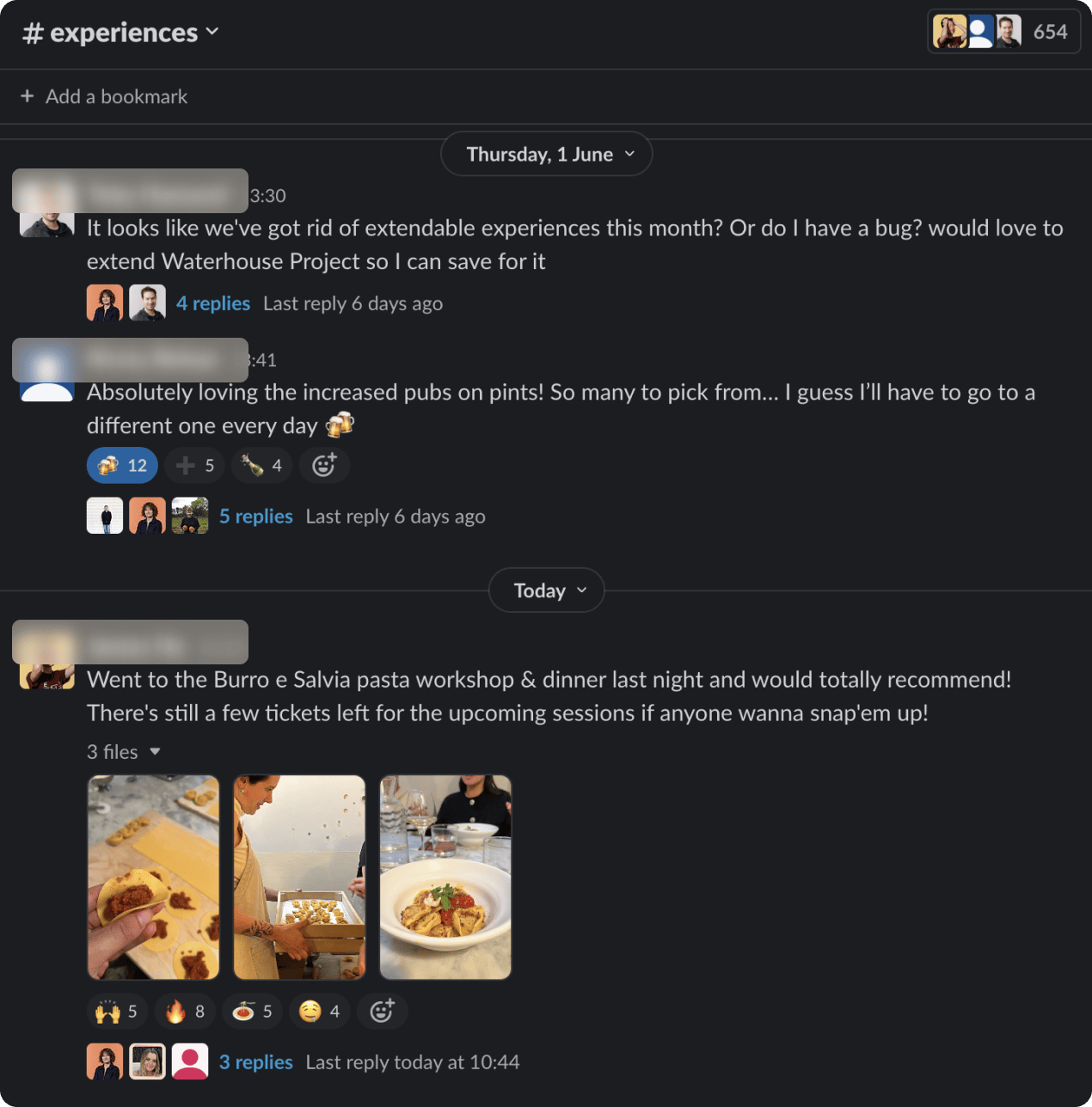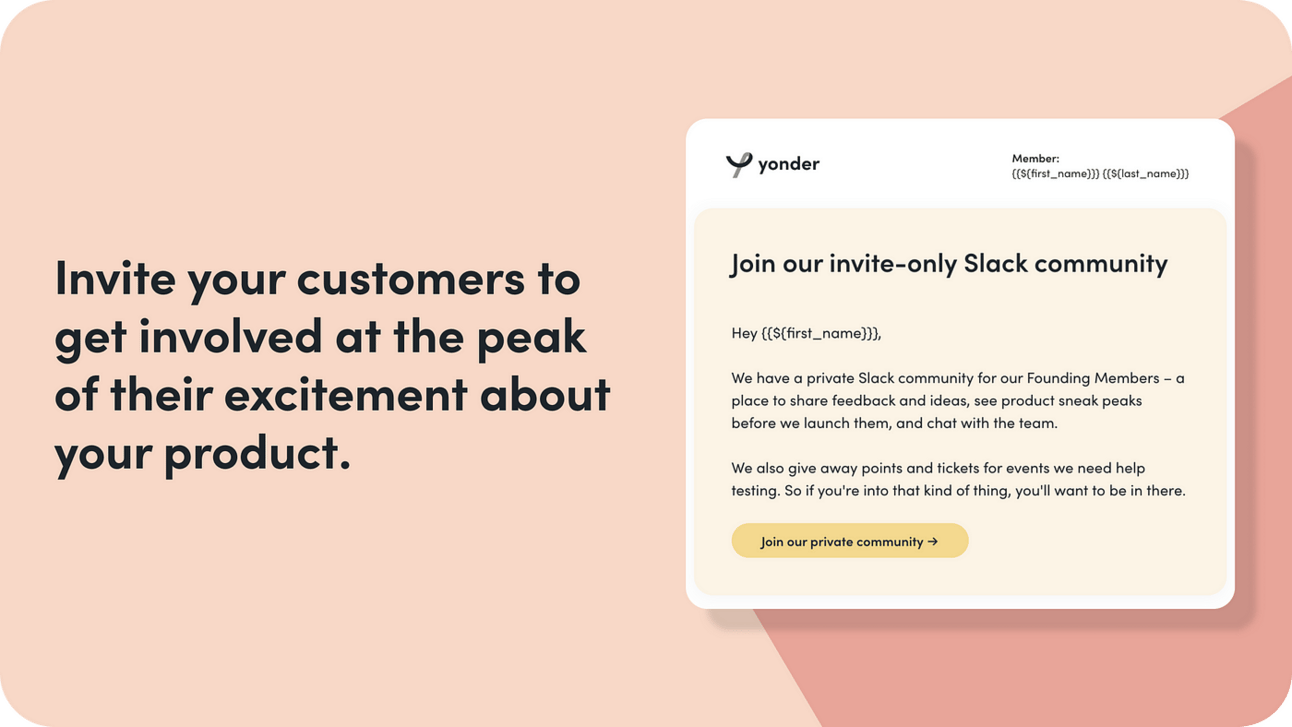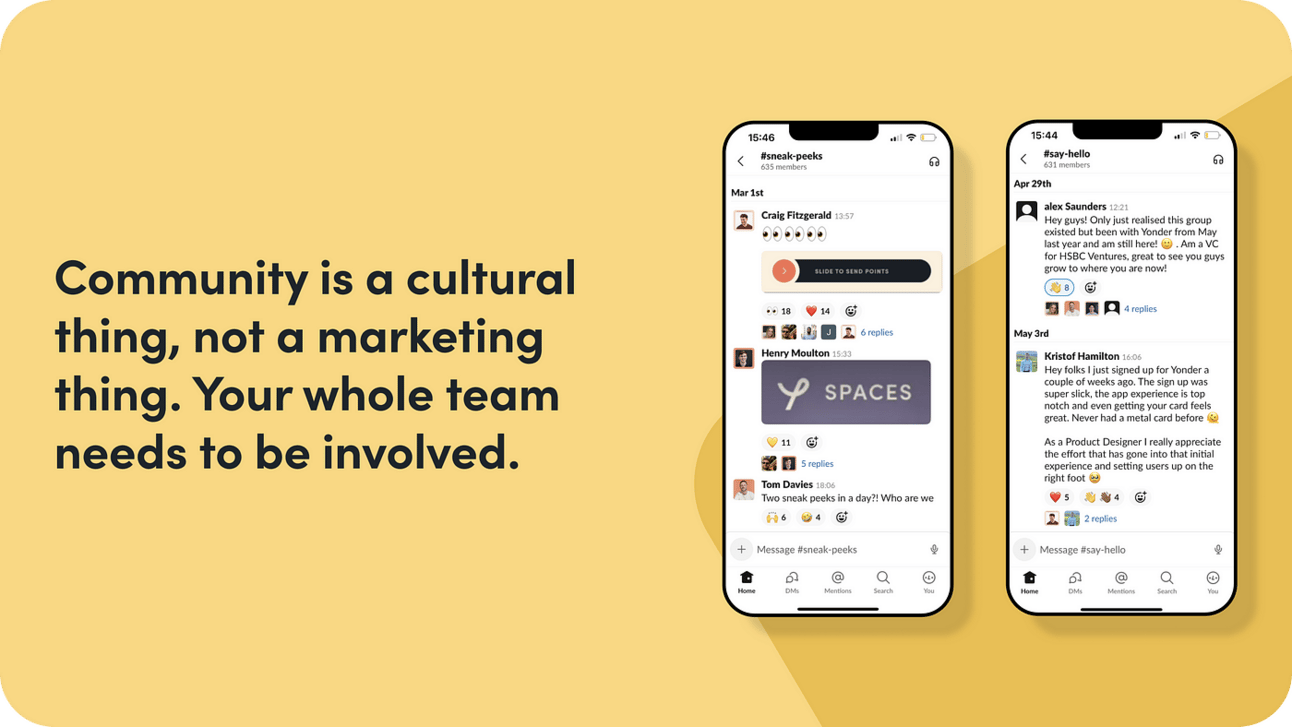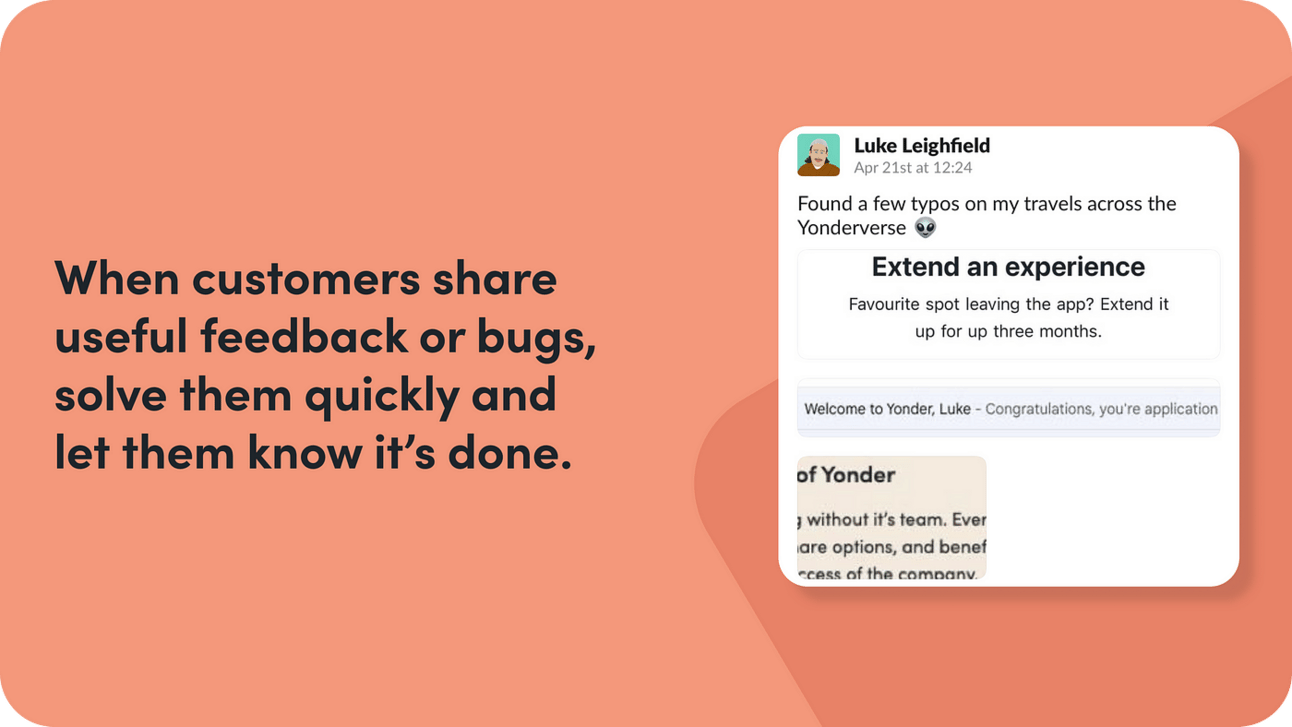- Marketing is Hard!
- Posts
- How to Build a Community For Your Startup
How to Build a Community For Your Startup
My easy-to-follow, patent-pending 5 step plan to build
This is a repost from an old article I wrote. Think of this as the Taylor’s Version while I reclaim my IP from Medium. So read this and imagine it’s 2022…
Before we get going, let me give you some context. I’m the VP of Marketing at Yonder, a new credit card launched in London last year. Yonder is a rewards credit card for the next generation of city adventurers — helping young people build good credit habits while enjoying rewards at the best spots in town.
I’ve written a few reflections about what I’ve learnt as we built and launched Yonder, and you may want to give those a read first.
What is community marketing anyway?
If you ask your mum, she’ll tell you that community is the warm feeling of support you get from the people who live around you. It’s the cookie fundraisers for school trips, watering your plants while you’re away and picking your kids up from school when you’re busy. It’s the selflessness of supporting the people around with shared interests, for no reason other than it feels like the right thing to do.
And, honestly, it’s not that far off from what community marketing is too. It’s a strategy where your customers spend time supporting your startup because they want you to succeed. Sounds lovely, and when you do it properly, it is.
Community marketing is about conversation. It’s the blending of lines between the team who build the company and the customers who use their products. It’s the shared journey towards value — for companies and their customers.
How community looks at Yonder
As Yonder’s Head of Marketing, I’ve done a lot poorly. Maybe I’ll write it all down and set it on fire in some cathartic exercise one day. Thankfully, our community strategy is not one of them.
Community has been our super-power, with 600+ early adopters that we call our Founding Members. They refer more often, churn rarely and made up more than 80% of our crowdfund campaign that was funded in just under 48 hours. They leave thoughtful and helpful reviews online that have helped us sustain a 4.8 Trustpilot rating and finish in the British Bank Awards with a perfect 5-star rating.

While we engage with our Founding Members in a few ways, our main platform for conversations has been on Slack where we speak with them every day. In return, they share ideas, complete surveys, give us quick feedback, log bugs, and send photos from the rewards that Yonder helps them unlock.
It’s far and away the most impactful part of our marketing strategy since we launched. I’m probably biased, but I haven’t yet seen a better example out there.
Okay, let’s get into it.
5 steps to build your community from scratch
1. Define your comically specific target audience
If you haven’t done this already, then you should go back a few steps in your product development and spend some time on it.
For us, that was a person living in Zones 1+2 in London, who works in tech, spends their disposable income on dining out and travel, reads publications like TechCrunch, loves trying new tech products and goes to tech meet-ups to chat with people about what they’re up to.
By being that specific, we could work out exactly where to find them and build our strategy around getting them involved. Think about things like:
Who are they? Where are they? What are their interests? Why would they want to help your business for free? Why would they take time out of their day to interact in your community? Where are they spending their time on the internet already?
2. Define what you want from your community
When your founder or CEO asks you to “make a community”, what they’re really asking is for you to magically create a world where your customers are obsessed with your brand, talk about it with everyone and share feedback and ideas for free in their spare time. Good luck.
Now, depending on your target audience above, you may find that a community strategy just isn’t right for you. Maybe your customers are older and not interested in engaging, or they’re busy parents and don’t have time. There are plenty of other marketing strategies you can employ. Don’t force it.
The most important question to ask yourself here is — what will they talk about?
What worked in our favour is that Yonder is used almost daily by our customers. We have a rewards program that updates every month. We have regular campaigns, product updates and meet-ups. There are so many reasons for them to be engaging with us.
If your customers only need to use your product every now and then, it’s going to be very difficult for you to convince them to engage with you daily. What are they going to talk about? If you don’t have a good answer, that’s your answer. Community may look quite different for your business. Try things like meet-ups, user research sessions or longer form feedback you request from them in exchange for some cash.
Setting your expectations ahead of time and in the context of your product, industry and target customer is essential. And will help articulate to your founders or board or whoever what community can realistically look like for you. You can’t force people to engage. Community will look different for everyone. Build your strategy around what you want to get out of it, not what it should look like. This is why it’s so important to be clear on your goals.
When we started building our community strategy, we had two goals:
Have our marketing punch above its weight — build a small but mighty group of advocates who will be happy to write reviews, refer friends, share user-generated content and support social campaigns
Get quick, actionable feedback — identify edge cases, gather feedback, and squash bugs quickly with the help of hundreds of customers
3. Choosing a platform where they‘re already spending their time
For us, that was Slack. Our target audience work in tech, so they’re already using Slack on their desktops all day. Adding a Yonder community in there made perfect sense. It also gave us greater control over who could access it, how we segment information through different channels and, importantly, made sure everyone had a name and photo.
A key part of my decision to use Slack was that users must have their email, name and often a photo. Internet anonymity does horrible things to people, often leading them to speak to people in ways they wouldn’t dream of in real life. I wanted our Slack group to feel like a virtual meet-up.
Other options include:
WhatsApp group: great for smaller groups of less than 20 people
Slack: great for tech workers and segmenting conversation
Facebook group: great for older audiences, like your aunty
Discord: great for crypto and other types of scams lol
Private Twitter or Instagram: great for global products
Reddit and other online forums: great for anonymous conversation
4. Seed your community with people and content
Have you ever arrived to a party early and there’s no one there? I’m always on time. I do this a lot. London has taught me to be an hour late to everything. It’s something I’m working on. The reason people are fashionably late is so they just launch right into the good part. Make sure your party is already going when people start to show up.
An easy way to do this is to get all of your team, friends and family into your community before you start to invite others. That way, when you start to invite your first set of customers, there’s already 30–40 people in there having fun.
We added in an automated message that goes to everyone who joins our community. It prompts them to post a message in our #say-hello channel where the whole Yonder team (and other members) welcome them. Once someone has a nice first experience, there way more likely to message again.
When they see existing conversations going on, it’ll do two good things:
It gives new people confidence that they’ve arrived somewhere fun and interesting that is alive and kicking. They’re more likely to engage when they see others doing it.
It sets an example of what is expected. When they see others engaging, asking questions and doing so in a friendly and supportive way, it’ll subconsciously push them to do the same.

5. Invite customers at the peak of their excitement
The best time to invite your customers to participate in your community is when they’ve just made a purchase or something else equally exciting.
For us, we sent an automated email when you activated your card. So even though it was a few days after you signed up, you’ve just had an amazing card opening experience and you’re excited to try your new card out. At that point we ask them if they’d like to be involved in our exclusive community.
We made them feel special by outlining some of the benefits they’d get just for being involved. Because we knew our target audience so well, we knew things like product sneak peeks and direct access to the team would be appealing to them.
Here are my key learnings and reflections on community building

Authentic communities don’t feel like marketing
At Yonder, we knew most of our first 200 customers by name. We knew where they came from, how they heard about us, and spoke to them regularly. I’ve probably spoken to around 400 of our Founding Members in our Slack. It’s been a hugely time intensive part of my role but I do it because it’s an important part of how we connect with our customers.
The best communities aren’t run by marketing teams, they’re run by people. Our community shouldn’t ever feel like a marketing channel, but rather a home for us to have engaging, two-way conversations with customers.
From the very beginning I’ve been clear to the team at Yonder — building community is a responsibility we all share. If your founder wants you to build a community, they need to be as involved as you.
People will mimic the behaviour they see
Thankfully we’ve been fortunate to avoid any antisocial behaviour in our community. Sadly however, most online communities become more toxic over time. Negative behaviour (disrespectful or demanding conversation, bullying etc.) drives away people who looking for positivity. That means there are fewer positive conversations over time, which exacerbates the problem.
Using a tool like Slack where users must add their names (and often photos) makes them more accountable for their behaviour than typical online forums. But that won’t do it alone.
It’s important to set the standard of communication for what you expect from your customers. Do not be shy about calling out anti-social or rude behaviour. People can become a little insensitive when sharing feedback behind their keyboards that they wouldn’t deliver the same way in person.
Give nasty people a warning then punt them out. Your life is stressful enough. You don’t need some little shit giving you a hard time. Startups are bloody hard at the best of times.

Take their feedback and put it into action quickly
The flip side to dealing with difficult customers is making sure your team can deal with fair and difficult feedback. If you want your customers to be sharing feedback, you’ll need thick skin and an open mind to really take your customer’s feedback on board.
It’s important to do something with the feedback too. We have countless examples of people sending us a bug and we’ve fixed it and let them know a few minutes later. When a person is used to feedback going nowhere, there’s a huge opportunity for you to build real brand love when they know they’re being listened to.
Know when to turn it off or change things up
At some point, you may outgrow your community strategy. And you’ll need to work out what community looks like for you at scale. Some companies never make this change, and they pay for it longer term.
It doesn’t mean abandoning your early customers, but moving to a different communication method (like email, online events etc.) may better serve you once you grow.
Not everyone will be engaged
I like to think we have a highly engaged community. Of the 650 we have now, I suspect about 40% have only really ever logged in once or twice. Meaning most of our conversation is coming from around half of our members. You can roughly expect the engagement to look like:
2–3% super active
10–15% active
40% read-only
40% not active at all
General guidance for content
Don’t be too conservative
If what we’re sharing feels too censored, or vague, it won’t be interesting enough. Ask yourself — would I find this interesting if I was a customer?
Invite people to engage with a post
Try asking things like what do you think, do you have any feedback, how do you think about this problem?
Make it brief, make it visual
Everyone’s brains are broken so give them something shiny to grab their attention. If your community is on Facebook or Twitter, you’ll be competing with all the other crap in their feed.
Let me know how you go
With a bit of luck, a decent product, and your team behind you, you should be on your way. I hope some of this was helpful. If you have questions, you can find me on LinkedIn.
And if you want to become a Yonder member, you can apply here.
Reply